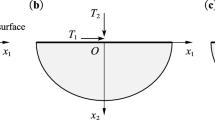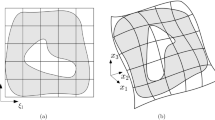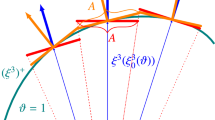Abstract
A new analytical procedure is developed for the deduction of the asymptotic series of the singular solutions in displacements and stresses near the vertex of the linear elastic isotropic corners with the Dirichlet–Robin (fixed-spring) and Neumann–Robin (free-spring) boundary conditions. Under the assumption of antiplane shear loading, the corresponding elastic problem reduces to the Laplace equation for the out-of-plane displacement. In the deduction of such singular solution, the complex variable is used to propose a harmonic function in the form of an asymptotic series including both power and logarithmic terms. This original procedure is suitable for its implementation in a computer algebra software which makes all the necessary symbolic computing, simplifications and rearrangements. This is a key issue due to the fact that the complexity of terms in these series may increase with increasing order of terms. These series are composed by the main terms (also called main singularities), solutions of the corresponding Dirichlet–Neumann or Neumann–Neumann problems, and the associated finite or infinite series of the so-called shadow terms (also called shadow singularities). These terms are determined by solving systems of recursive inhomogeneous Dirichlet–Neumann or Neumann–Neumann problems, respectively. A general classification of the behaviours of the asymptotic series covering all the considered corner problems is introduced. A few examples of the asymptotic series for corners with Dirichlet–Robin and Neumann–Robin boundary conditions are presented to illustrate the capabilities of this procedure.






















Similar content being viewed by others
Notes
The following subsets of real numbers will be used in this work: \({\mathbb {Z}}\) the set of integer numbers, \({\mathbb {N}}\) the set of natural numbers, \({\mathbb {Q}}\) the set of rational numbers, and \({\mathbb {N}}_{0}={\mathbb {N}}\cup \{0\}\) the set of non-negative integers.
The authors thank to Professor Serge Nicaise (Université Polytechnique Hauts-de-France, Valenciennes) for calling their attention to this non-uniqueness issue.
References
Antipov YA, Avila-Pozos O, Kolaczkowski ST, Movchan AB (2001) Mathematical model of delamination cracks on imperfect interfaces. Int J Solids Struct 38(36–37):6665–6697
Barber JR (2010) Elasticity. Springer, Dordrecht
Barroso A, Mantič V, París F (2003) Singularity analysis of anisotropic multimaterial corners. Int J Fract 119(1):1–23
Benveniste Y, Miloh T (2001) Imperfect soft and stiff interfaces in two-dimensional elasticity. Mech Mater 33:309–323
Cornetti P, Corrado M, Lorenzis LD, Carpinteri A (2015) An analytical cohesive crack modeling approach to the edge debonding failure of FRP-plated beams. Int J Solids Struct 53:92–106
Costabel M, Dauge M (1993) Construction of corner singularities for Agmon–Douglis–Nirenberg elliptic systems. Mathematische Nachrichten 162(1):209–237
Costabel M, Dauge M (1996) A singularly perturbed mixed boundary value problem. Commun Partial Differ Equ 21(11–12):1919–1949
Costabel M, Dauge M (2002) Crack singularities for general elliptic systems. Mathematische Nachrichten 235(1):29–49
Costabel M, Dauge M, Yosibash Z (2004) A quasi-dual function method for extracting edge stress intensity functions. SIAM J Math Anal 35(5):1177–1202
Dempsey JP, Sinclair GB (1979) On the stress singularities in the plane elasticity of the composite wedge. J Elast 9(4):373–391
Dillard DA, Mukherjee B, Karnal P, Batra RC, Frechette J (2018) A review of Winkler’s foundation and its profound influence on adhesion and soft matter applications. Soft Matter 14:3669–3683
Erdogan F (1997) Fracture mechanics of interfaces. In: Rossmanith HP (ed) Damage and failure of interfaces. Balkema Publishers, Rotterdam, pp 3–36
Geymonat G, Krasucki F, Lenci S (1999) Mathematical analysis of a bonded joint with a soft thin adhesive. Math Mech Solids 4:201–225
Goland M, Reissner E (1944) The stresses in cemented joints. J Appl Mech 11:A17–A27
Grisvard P (1985) Elliptic problems in nonsmooth domains. Pitman, Boston
Grisvard P (1992) Singularities in boundary value problems. Springer, London
Hashin Z (2002) Thin interphase/imperfect interface in elasticity with application to coated fiber composites. J Mech Phys Solids 50:2509–2537
Hwu C, Omiya M, Kishimoto K (2003) A key matrix N for the stress singularity of the anisotropic elastic composite wedges. JSME Int J Ser A 46:40–50
Kashiwabara T, Colciago C, Dedè L, Quarteroni A (2015) Well-posedness, regularity, and convergence analysis of the finite element approximation of a generalized Robin boundary value problem. SIAM J Numer Anal 53(1):105–126
Kondratiev VA (1967) Boundary-value problems for elliptic equations in domains with conical or angular points. Trans Moscow Math Soc 16:227–313
Leguillon D, Sanchez-Palencia E (1987) Computation of singular solutions in elliptic problems and elasticity. Masson, Paris
Lenci S (2001) Analysis of a crack at a weak interface. Int J Fract 108:275–290
Mantič V, París F, Berger J (2003) Singularities in 2D anisotropic potential problems in multi-material corners. Real variable approach. Int J Solids Struct 40:5197–5218
Mantič V, Barroso A, París F (2014) Singular elastic solutions in anisotropic multimaterial corners. Applications to composites. In: Mantič V (ed) Mathematical methods and models in composites. Imperial College Press, London, pp 425–495
Mantič V, Távara L, Blázquez A, Graciani E, París F (2015) A linear elastic-brittle interface model: application for the onset and propagation of a fibre-matrix interface crack under biaxial transverse loads. Int J Fract 195:15–38
Mazya V, Rossmann J (1992) On a problem of Babuška (Stable asymptotics of the solution to the Dirichlet problem for elliptic equations of second order in domains with angular points). Mathematische Nachrichten 155(1):199–220
Medková D (2018) The Laplace equation boundary value problems on bounded and unbounded Lipschitz domains. Springer, Cham
Mghazli Z (1992) Regularity of an elliptic problem with mixed Dirichlet-Robin boundary conditions in a polygonal domain. Calcolo 29(3–4):241–267
Mishuris G (2001) Interface crack and nonideal interface concept (Mode III). Int J Fract 107:279–296
Mishuris GS, Kuhn G (2001) Asymptotic behaviour of the elastic solution near the tip of a crack situated at a nonideal interface. ZAMM Zeitschrift für Angewandte Mathematik und Mechanik 81(12):811–826
Nicaise S, Li H, Mazzucato A (2017) Regularity and a priori error analysis of a Ventcel problem in polyhedral domains. Math Methods Appl Sci 40(5):1625–1636
Omer N, Yosibash Z, Costabel M, Dauge M (2004) Edge flux intensity functions in polyhedral domains and their extraction by a quasidual function method. Int J Fract 129(2):97–130
Paggi M, Carpinteri A (2008) On the stress singularities at multimaterial interfaces and related analogies with fluid dynamics and diffusion. Appl Mech Rev 61:020801-1–22
Prandtl L (1933) Ein Gedankenmodell für den Zerreißvorgang spröder Körper (A thought model for the fracture of brittle solids). Zeitschrift für Physik Angenwandte Mathematik und Mechanik 13(2):129–133, Translation: Knauss W. G. Int J Fract (2011) 171:105–109
Sinclair GB (1996) On the influence of cohesive stress-separation laws on elastic stress singularities. J Elast 44:203–221
Sinclair GB (1999) A note on the removal of further breakdowns in classical solutions of Laplace’s equation on sectorial regions. J Elast 56:247–252
Sinclair GB (2004) Stress singularities in classical elasticity–I: Removal, interpretation and analysis, –II: Asymptotic identification. Appl Mech Rev 57(4):251–297, 385–439
Sinclair GB (2009) A note on the influence of cohesive stress-separation laws on elastic stress singularities in antiplane shear. J Elast 94:87–93
Sinclair GB (2015) On the influence of adhesive stress-separation laws on elastic stress singularities. J Elast 118:187–206
Steigemann M (2015) Power-law solutions of anisotropic multi-material elasticity problems. J Elast 118:63–87
Ting TCT (1997) Stress singularities at the tip of interfaces in polycrystals. In: Rossmanith HP (ed) Damage and failure of interfaces. Balkema Publishers, Rotterdam, pp 75–82
Valoroso N, Champaney L (2006) A damage-mechanics-based approach for modelling decohesion in adhesively bonded assemblies. Eng Fract Mech 73:2774–2801
Vasilopoulos D (1988) On the determination of higher order terms of singular elastic stress fields near corners. Numer Math 53(1–2):51–95
Volkersen O (1938) Die Nietkraftverteilung in Zugbeanspruchten Nietverbindungen mit Konstanten Laschen-querschnitten. Luftfahrtforschung 15:41–47
Wang CH, Rose LRF (1999) A crack bridging model for bonded plates subjected to tension and bending. Int J Solids Struct 36:1985–2014
Wieghardt K (1907) Über das Spalten und Zerreissen elastischer Körper (On splitting and cracking of elastic bodies). Zeitschrift für Mathematik und Physik 55(1-2):60–103, Translation: Rossmanith H.P. Fatigue Fract Eng Mater Struct (1995) 12:1371–1405
Williams ML (1952) Stress singularities resulting from various boundary conditions in angular corners of plates in extension. J Appl Mech 19:526–528
Winkler E (1867) Die Lehre von der Elasticität und Festigkeit mit besondere Rücksicht auf ihre Anwendung in der Technik, für polytechnische Schulen, Bauakademien, Ingenieure, Maschienenbauer, Architecten, etc. Verlag von H, Dominicus, Prag
Wolfram S (1991) Mathematica. A system for doing mathematics by computer. Addison-Wesley, Redwood City
Yin WL (2003) Anisotropic elasticity and multi-material singularities. J Elast 71:263–292
Yosibash Z (2012) Singularities in elliptic boundary value problems and elasticity and their connection with failure. Springer, New York
Acknowledgements
The authors thank to Professor Serge Nicaise (Université Polytechnique Hauts-de-France, Valenciennes) for calling their attention to the issue of non-uniqueness of shadow terms. The research was conducted with the support of the Spanish Ministry of Science, Innovation and Universities and European Regional Development Fund (Project PGC2018-099197-B-I00), and the Junta de Andalucía and European Regional Development Fund (Projects US-1266016 and P18-FR-1928).
Author information
Authors and Affiliations
Corresponding author
Additional information
Publisher's Note
Springer Nature remains neutral with regard to jurisdictional claims in published maps and institutional affiliations.
Rights and permissions
About this article
Cite this article
Jiménez-Alfaro, S., Villalba, V. & Mantič, V. Singular elastic solutions in corners with spring boundary conditions under anti-plane shear. Int J Fract 223, 197–220 (2020). https://doi.org/10.1007/s10704-020-00443-5
Received:
Accepted:
Published:
Issue Date:
DOI: https://doi.org/10.1007/s10704-020-00443-5




